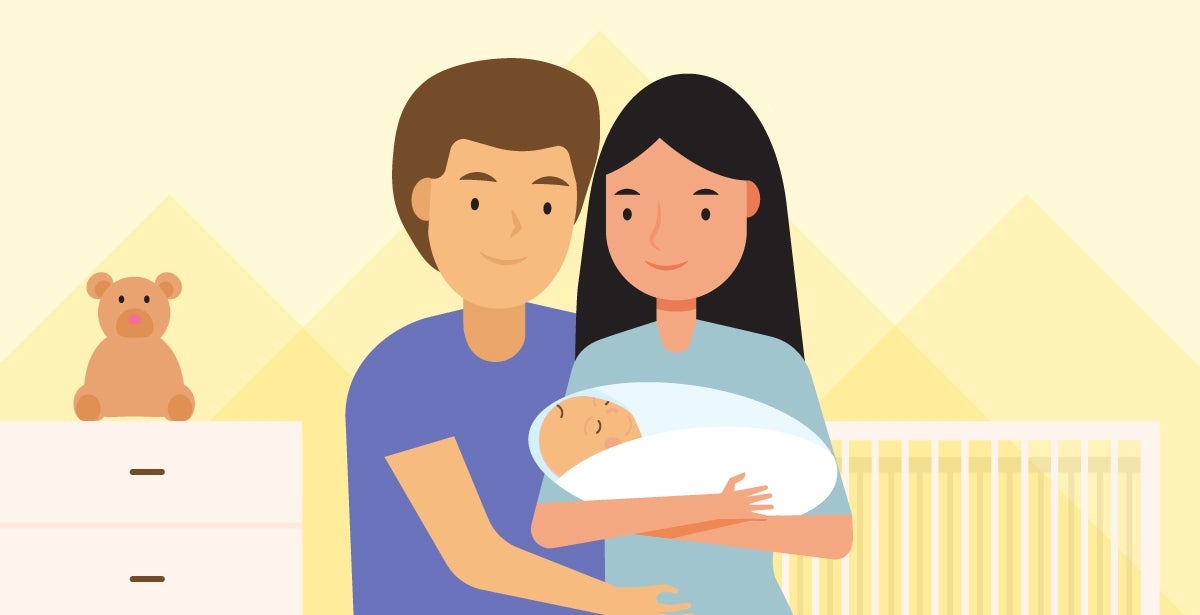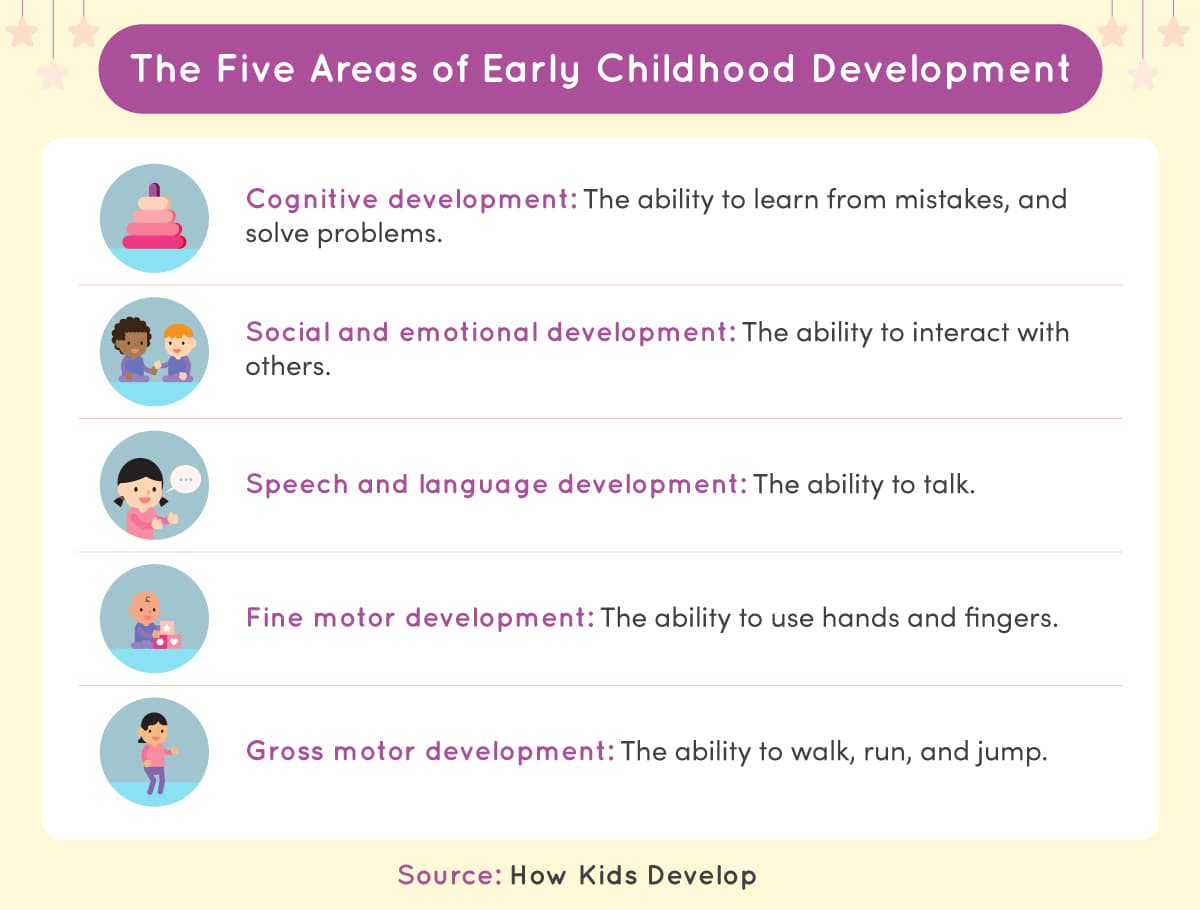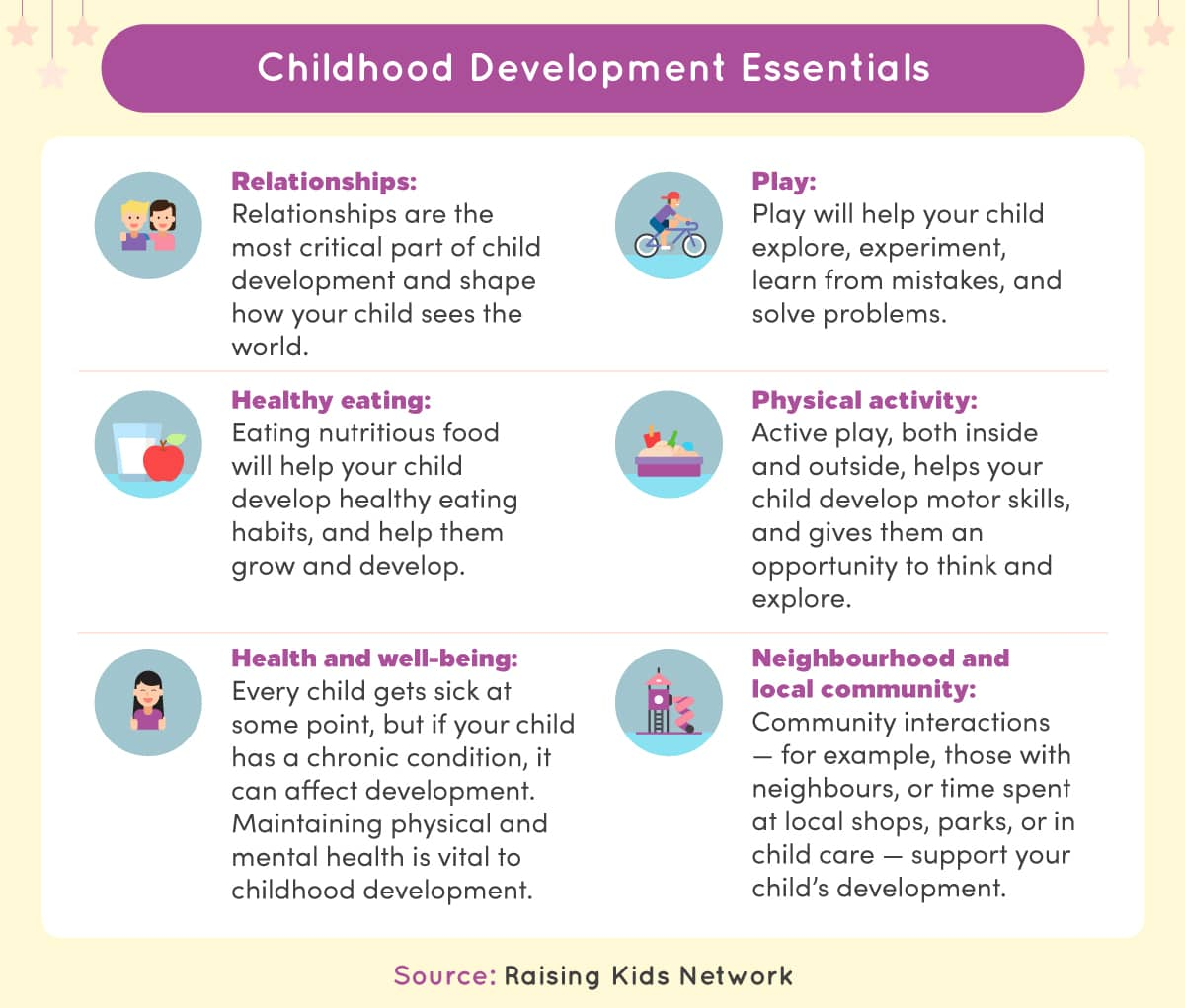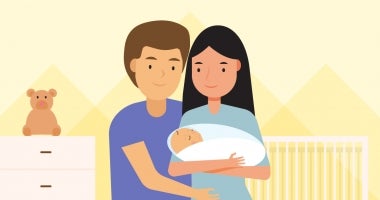
Early Childhood Development: What Happens in the First Eight Years
The first eight years of a child’s life are widely accepted as the most critical a human being experiences. In these formative years, children learn many of the skills they’ll need to function in society, from throwing a ball to tying their shoelaces. The first eight years of a child’s life also shape who they will be as a person. In those years, they start to build foundational values and ideas about life; what to expect, and how to act.
The importance of early childhood cannot be underestimated. Throughout these early years, children develop according to a set of milestones. While specialists compare children’s development to a general timeline, different children reach these milestones at different times.
This article will explore early childhood development in more detail and introduce the five key areas of development. It will discuss childhood development essentials, as well as briefly explore expected milestones in development, and what to do if they go unmet.
About Early Childhood Development
Early childhood development refers to how a child grows and develops physically, emotionally and socially in the first years of life. It also refers to how their communication and cognitive skills develop over time. All of these areas of development are intricately linked, and are important in a child’s early years.
The first eight years of development are truly a remarkable time in a human being’s life. In these years, a child’s experiences and relationships help them form millions of brain connections that will create pathways for how they behave throughout their lives. At no other time in a human’s life does the brain form as many connections as it does in the first eight years.
Experiences and relationships are key to how a child develops, and in the first eight years a lot of learning is achieved through play. However, other factors can also affect children’s development, including genetics, nutrition, level of physical activity, overall health and the community that surrounds them.
The Five Key Areas of Early Childhood Development
Within the first five years, children develop in five key areas. Each area is interrelated and helps a child move, act and function more independently.

1. Cognitive Development
Cognitive development refers to children’s ability to learn, understand their environment and begin to solve problems on their own.
This development can mean different things at different ages. For example, as a baby, solving problems may refer to exploring the immediate environment with hands and mouth. For a 5-year-old, problem-solving may refer to tying shoelaces, eating with cutlery or even solving simple mathematical problems.
2. Social and Emotional Development
Social and emotional development refers to children’s ability to interact with others and their environment. It also refers to the ability to help themselves complete a task and exercise self-control when doing so.
This type of development also means different things at different ages. For example, a very young baby may show social development through a smile, whereas an older baby may show this through a wave or a cuddle. At later stages, children may show social and emotional development by sharing or playing games with others.
3. Speech and Language Development
When children’s speech and language development advances, they develop their ability to communicate in various ways. As communication is complex and involves more than simply vocabulary, this type of development manifests in different ways.
At a young age, speech and language development can be as simple as responding to certain commands, such as “sit down” or “look over there.” As children grow, their language skills improve, and at around age two, many may be able to say certain words. As they grow older, children will master more complex language skills, such as the ability to understand different tenses and engage in conversations with others.
4. Gross Motor Skill Development
Alongside fine motor skill development, gross motor skill development in children’s early years help them perform everyday tasks. Gross motor skills refer to the larger muscles in the body and a child’s ability to control them. Early gross motor skill development may include a young baby learning to sit up, and an older baby learning to crawl. Later, older children learn more complex movements, such as the ability to skip and jump.
5. Fine Motor Skill Development
As children develop gross motor skills, they then begin to improve fine motor control. For example, they begin to use their whole hands to pick up objects, then move to finger control to perform tasks such as turning pages of a book.
Throughout the first eight years of life, children develop many fine motor skills. These often begin with the ability to pick up toys and are usually followed by the ability to hold cutlery, and then the ability to use pencils to draw.
Additional Resources
- Raising Children, Child Development in the First Five Years — High-level overview of early childhood development.
- Australian Early Development Census, Five Important Areas of Early Childhood Development — Government resources for early childhood development professionals.
Early Childhood Development Essentials
Within their first eight years of life, children learn and develop at different rates. Many will progress toward some milestones quickly, while others will take longer. Furthermore, some children will progress toward outcomes in different, yet equally meaningful ways. There is no one set path for development, and parents must remember that learning is not always predictable and linear.
Also, development is not a race to the finish line. It is important to not read too much into the development of children who may or may not achieve certain milestones early or later. Despite this, there are an internationally recognised set of milestones that most children meet at certain ages. These milestones should be used only as guidelines. If parents are concerned, they should check with their health professional before jumping to conclusions.
Relationships
Healthy, loving relationships are essential for children, and positively affect all stages of their development. They are considered the foundation of child development. Through relationships, children learn how to see, respond to, and interact with the world. From birth, children learn how they should act based on how others respond. For example, when a baby cries and their mother comforts them, the baby feels assured that they are loved and that their needs are met.
Children not only learn from their own relationships but from the relationships of those around them. For example, they learn how to treat others by seeing how their parents and other people in their house interact with each other. Observing these relationships will form the basis for how children behave and communicate.
Play
Alongside relationships, play is one of the most critical ways that children develop in their early years. Play is much more than simply having fun — it is an important mechanism for helping children explore, experiment, interact and solve problems. Through play, children learn critical skills including how to think for themselves, move, interact respectfully with others and communicate.
The definition of play can encompass anything from talking to children about their surroundings, to physically interacting with toys, play equipment and much more. To foster the best development through play, parents should strike a balance between supporting and encouraging their children to play, and interacting in play themselves. They should also talk, listen and interact with their children about what they are playing and how to play.
Healthy Eating
Relationships and play form the foundations of child development. Yet alongside these, a number of other criteria must be met. One such criteria to support optimal development is healthy eating. Children need the proper nutrients and energy levels to develop. These are obtained through healthy food, as well as healthy eating patterns.
Parents should encourage healthy eating habits. These habits include always having fresh fruit handy for snacks; encouraging children to try vegetables with different textures, colours and tastes; and involving children in planning and preparing meals.
Physical Activity
Physical activity is another important element that aids optimal development. Physical activity is important as it helps children develop their motor skills, gives them an opportunity to explore, and helps them think and solve problems. Physical activity also keeps them healthy and develops important muscles.
To aid development, parents should provide their children plenty of opportunities to be physically active, both inside and outside.
Health and Well-being
In a child’s early years, routine illnesses should be expected. Children pick up many germs, and becoming ill from time to time is part of developing their immune system. Illnesses such as colds, tummy upsets and earaches can all form part of a child’s development, yet usually do not present any long-term effects. However, some illnesses in children can affect their development. Chronic illnesses or long-term conditions can be detrimental, as can disabilities.
If parents are concerned that their child is not meeting developmental milestones, they should consult a health professional to check for underlying health conditions.
Neighbourhood and Local Community
In a child’s early years, forming positive relationships with friends and neighbours helps them develop important social skills. Interacting with the community in other ways also aids this development. This may include visiting playgrounds, parks, playgroups and libraries, and attending maternal health nurse checkups.
For optimal child development, all six of the elements discussed here should be present in a child’s life. However, at various stages some elements are more important. For example, young babies will likely form relationships with their parents long before they form community relationships.
Additional Resources
- Move to Maximise, Essentials for Childhood Development — A list of eight key ways to support child development.
- Learning Policy Institute, Early Childhood Essentials — Framework for parents on the key skills children should work on before beginning kindergarten.
- Centre on the Developing Child, 8 Things to Remember about Childhood Development — Research-based information on childhood development for parents and caregivers.

What Are the Expected Milestones in Early Child Development?
Throughout the first five years of life, children grow, learn and develop at different paces. Some develop a number of skills quickly, whereas others take longer. Each child is unique and progresses in different ways. Learning is not always predictable, but can be achieved in equally meaningful ways.
Parents should remember that reaching certain milestones quickly is not necessarily better than reaching them later. To serve as a guide, development practitioners and parents can refer to a universally accepted set of milestones that children should reach at different ages. If parents are concerned, they should reach out to a health professional.
Definition of an Early Childhood Development Milestone
An early childhood development milestone is defined as when a child acquires a skill within a certain period of time. For example, one milestone is the ability to talk, which usually occurs between the ages of 18 and 30 months. Early childhood development does not always follow a straight line, but it does occur in a sequential fashion. This means that children generally need to hit certain milestones before they can progress to the next ones. For example, children need to be able to crawl before they can walk.
Early Childhood Development Milestones: Birth to four months
In the first few months of life, there are many important milestones that parents and educators should observe across physical, social, emotional, cognitive and language areas.
Physical
- Has a startle reflex when loud noises are heard.
- Turns head when cheek is touched.
- Reaches for dangling objects.
Social
- Smiles and laughs.
- Makes eye contact (with an adult’s face about 20cm away).
Emotional
- Cries (peaks at six to eight weeks, and levels off at 12-14 weeks).
- Shows excitement when preparing to feed.
Cognitive
- Eyes track moving targets for a brief period.
- Is interested in patterns, edges, and contrasts with light/dark and faces.
Language
- Soothed by sound of voices.
- May begin to copy sounds.
Early Childhood Milestones: Four to eight months
Many significant milestones also take place in the four to eight month age range.
Physical
- Plays with feet and toes.
- Makes effort to sit independently, but may need support.
Social
- Reacts positively to the presence of another baby or child.
- Responds to their own name.
Emotional
- Starts to learn to self soothe, either with thumb or a doll.
- Begins to show wariness toward strangers.
Cognitive
- Becomes bored if left alone for a prolonged period.
- Explores objects with mouth.
Language
- Repeats sounds, babbles.
- Makes sound in response to others.
Early Childhood Milestones: Eight to twelve months
As children approach age one, many important milestones are achieved.
Physical
- Pulls up to a standing position (with hands held).
- Transfers objects between hands, explores objects with hands.
- Attempts to feed themselves, can grasp a spoon or fork.
Social
- Is wary of strangers.
- Imitates actions of others.
Emotional
- Seeks out parents or caregivers, shows signs of anxiety when they walk away.
- Offers toy to adults but does not hand it over.
Cognitive
- Moves items away to retrieve desired toy or object.
- Communicates through gestures.
Language
- Babbles, says basic words.
- Shouts to attract attention.
Early Childhood Milestones: One to two years
The second year of life is just as exciting as the first from an early childhood development perspective. Parents and educators may see many milestones.
Physical
- Walks, runs, jumps, climbs.
- Attempts to turn pages of a book.
Social
- Begins to cooperate when playing.
- Plays alongside others, may interact or copy.
Emotional
- Seeks comfort when upset.
- Takes cues from others regarding attitudes to strangers.
- Assists another in distress by making sympathetic noises or offering comfort.
Cognitive
- Knows body parts, points to body parts in a game.
- Recognises self in a photo or mirror.
Language
- Follows simple commands.
- Says name and other words.
Early Childhood Milestones: Two to three years
By the third year of life, children develop a lot more independence. Here are some milestones parents and educators may see.
Physical
- Holds a crayon or pencil to scribble.
- Gets dressed with assistance.
Social
- Enjoys simple make-believe.
- May prefer same-sex playmates.
Emotional
- Shows strong attachment to main caregiver.
- Demands adult attention.
Cognitive
- Builds towers and other structures.
- Enjoys playing in sand, with water and with other tangible objects.
Language
- Refers to self by name and often asks for ‘mine’.
- Asks lots of questions.
Early Childhood Milestones: Three to five years
From three to five years, children gain even more independence, and develop many cognitive and higher-order functioning skills.
Physical
- Can dress and undress with less help.
- Hops, runs, jumps, gallops, skips.
Social
- May develop a particular friend.
- Can jointly work with other children to solve problems.
Emotional
- Understands when someone is hurt and tries to comfort them.
- May praise themselves.
Cognitive
- Uses objects to construct things.
- Engages in dramatic play, taking on character roles.
Language
- Tells stories.
- Constantly talks, may like to experiment with new words.
Early Childhood Milestones: Five to eight years
Many significant milestones are met between ages five and eight.
Physical
- Can balance on narrow planks.
- Dances for pleasure.
Social
- Engages in imaginative play.
- May be nervous of older children.
Emotional
- Shows friendliness and generosity.
- Shows a desire to excel.
Cognitive
- Can use symbols.
- Can read.
Language
- Vocabulary up to 3,000 words.
Additional Resources
Kid Sense, Development Milestone and the Early Years Learning Framework and Quality Standards — Comprehensive list of milestones, as well as a framework for interpreting them.
NHS, Maternal and Early Years — Government resources on early childhood development for parents and caregivers.
What to Do if Early Childhood Development Milestones Aren’t Met
Each child’s development journey will be unique, and there is a wide range of acceptable time frames when it comes to how and when a child develops. Children have different strengths and weaknesses, and as with any other type of learning they will do in their lifetimes, they can be supported in a variety of ways.
Children who may take longer to reach certain milestones may have what is called a development delay, and may need learning support.
Definition of an Early Childhood Development Delay
An early childhood development delay is defined as when a child is slower to develop physically, emotionally, socially, or in communication skills than would be expected, taking into account that each child is unique. As development is an individual journey, it is difficult to characterise exactly what a delay might be. For example, most children walk between eight and fifteen months. If a child isn’t walking at fifteen months, but is showing signs they will soon walk — for example, pulling themselves up and balancing — they may simply be slower to develop than other children. If they aren’t showing these signs, they may be experiencing a development delay. Parents should always check with a professional if they are concerned.
Risk Factors for Early Childhood Development Delay
Broadly, development delays fall into two categories: genetic and environmental. Each category can affect development differently.
Genetic Risk Factors
A child is said to be placed at a genetic risk for early childhood development delay if they are born with a genetic abnormality. One example is Downs syndrome, which causes developmental delays due to abnormal chromosomes.
Environmental Risk Factors
A child’s environment can also cause developmental delays. Environmental risks include being exposed to harmful chemicals before or during birth, including alcohol or drugs. Other environmental factors may include poor maternal nutrition or infections. A child’s life experiences can also affect development. For example, children who are born premature, or those who face poverty or see their parents experience depression, can also experience delayed development.
Warning Signs of Early Childhood Development Delay
All children should be monitored for signs of early childhood development delay. However, parents should be mindful that there might be a number of reasons for delays and also for certain warning signs. Parents should always consult their health professional for a diagnosis.
Behavioural Warning Signs
- Focuses or stares at objects for long periods of times, enjoys this more than interacting with others.
- Rarely makes eye contact.
- Gets frustrated easily when trying to do simple tasks.
- Displays violent behaviour.
Gross Motor Warning Signs
- Has a floppy or limp body posture compared to others.
- Uses one side of their body only.
Vision Warning Signs
- Turns, tilts or holds head in a strained position.
- Finds it hard to pick up objects (after 12 months of age).
- Closes one eye to look at objects in the distance.
Hearing Warning Signs
- Does not appear to hear when called from across the room.
- Turns body so one ear is listening for sound.
- Has difficulty understanding what is said or following directions by age three.
- Isn’t startled by loud noises.
How Is Early Childhood Development Delay Identified?
Only a trained professional can properly assess whether or not a child is experiencing a developmental delay. For children to be properly assessed, they need to undergo two different assessments: a developmental screen and a developmental evaluation. A developmental screen is a general measurement of a child’s skillset. The purpose is to ascertain whether or not the child may need further assessment or assistance. A screening test is usually given in the form of a questionnaire that a parent completes in conjunction with a health professional. If the developmental screen indicates the need, an evaluation will be the next step. A developmental evaluation is a more in-depth assessment. Here, a professional assesses a child’s skills and tests their strengths and weaknesses in all developmental areas. The assessment is used to determine whether a child needs early intervention services or a treatment plan.
Early Intervention Options
For parents whose children are classified as having an early childhood development delay, it is important to remember that many delays will not affect their child’s life forever, and that treatment is available through early intervention. Early intervention services include many different programs, remedies and medical treatments. They can include, but are not limited to, hearing technology or other audiology services, counselling, psychological services, nutrition assistance, educational programs, occupational therapy, speech or language intervention and many more.
Additional Resources
- Sydney Children’s Hospital, Development Delays — Fact sheets in multiple languages describing development delays.
- Raising Children Network, Development Delays in Children — Comprehensive health resources for parents and caregivers.
- Department of Social Services, Signs of Development Delay — Government resources for parents, caregivers, and professionals on development delays in children.
Early Childhood Development: A Unique Journey
Early childhood development is an exciting, one-of-a-kind journey for each child — and for the parents and educators who witness it. Parents and caregivers can play a critical role in a child’s early years by ensuring that children have access to supportive relationships, imaginative play, good nutrition, healthy physical activity and community support.
Become an exceptional leader in Education with ECU's online Master of Education. Call our student enrolment team on 1300 707 760 today.



